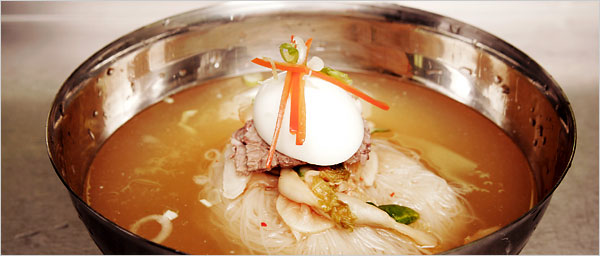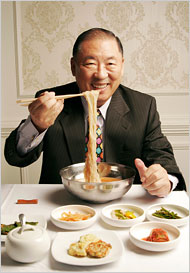|

It was a bowl of homemade buckwheat noodles — naeng myun — that she made in their home in Pyongyang, now North Korea. The noodles nested in cold, mild beef broth topped with slices of tender beef brisket, sweet Asian pear, lightly pickled white radish, cucumber and half a hard-boiled egg. Eating it was as close to an epiphany as a little boy can get. “There’s a little bit of sweetness, and a little bit of sourness,” said Mr. Kim, 73, through an interpreter, a daughter, Jenny Cha. “It’s very refreshing and very cool. If you ask me why I love it, I love it. Does there have to be a reason?”  | | Jung-Hyun Kim eats naeng myun, a popular Korean summer dish of noodles in a chilled broth that combines a touch of sweetness with a subtle sour note. |
In 1961, after settling in Seoul, South Korea, he opened a restaurant named Dae Dong specializing in naeng myun, the first of five of those restaurants he would open in Korea, Paraguay and New York before retiring. “If I want to eat it, I have to spend a lot of money,” he said recently over a bowl at Dae Dong in Flushing. “But if I do a naeng myun business, I can eat it whenever I want, and as often as I want.” He ate it daily, three times a day, until he retired in 1999. He is not alone in his love for the cold noodles, one of Korea’s most popular dishes, especially in the summer. The noodles, sometimes called Pyongyang naeng myun, are a light, one-dish meal with bursts of flavor — a crunch of mildly vinegared radish, a spurt of crisp, juicy pear and, of course, the savory noodles. A spicy, brothless version called Hamhung naeng myun, which originated in the city of that name in North Korea, is made with slightly chewier sweet-potato noodles and a sauce of minced fresh red chilies, fresh red bell peppers, garlic, ginger, onions, sugar or honey, ground sesame seeds and sesame oil. It’s topped with the same pyramid of brisket, pear, radish, cucumber and egg. the dish is served with a ladle of cold beef broth added to the noodles. A variation is topped with very chewy, raw skate rather than brisket. The best naeng myun are freshly made. At Dae Dong, Sang Sup Seo, the chef, mixed the dough from buckwheat flour, regular wheat flour, hot water and a splash of carbonated water mixed with rice vinegar, “to hold the dough together,” he said. With his fingers, he mixed it in the bowl of a machine that kneaded it and then extruded it in a cylinder 14 inches long by 3½ inches across, enough for 6 servings. The chef placed some dough into the steel cylinder of an automated noodle-making machine. He pressed a lever, pushed a button, and a cylinder pressed the dough through a perforated cap in 294 slender strands. The fragile pale beige noodles, each 2 feet long and a scant one millimeter in diameter, dropped out of the machine directly into a pot of boiling water. Mr. Seo twirled the noodles around for a minute and a half, removed them to a sink of cold water to stop the cooking, and then to a sink of ice water to make them firm. He mixed the noodles in a serving bowl with an icy slush of broth from a refrigerated steel tub and then anointed it with the pear, kimchi and beef. When the noodles were presented to Mr. Kim, he added a tablespoon of rice vinegar and a teaspoon of mustard, and gently mixed the noodles. (Waitresses offer to cut the noodles in half with scissors, since a skein of one-foot-long noodles is easier to eat than one of two-foot-long noodles.) Mr. Kim of Dae Dong recalled using a wooden noodle-making machine when he was growing up. The apparatus weighed about 30 pounds, and was communally owned by three or four families. When his family wanted to use it, a family member went to the neighbor’s house, dismantled the machine, and carried the parts home. Chang Lai Ahn, the chef at Kum Gang San, who has been making naeng myun for 40 years, had to push the dough through the old-fashioned machines using “brute force,” he said through an interpreter. Naeng myun is best eaten at restaurants, where it costs around $12. The noodles are not good for takeout. They will stick to each other, said Soo Lee, the manager of Kum Gang San. “They will become one chunk in 15 minutes.” “If you live next door, and you take this out,” Ms. Lee said, “you will take the noodles separate from the rest of the ingredients, and you can soak the noodles in ice water to separate them. But you would have to be next door.” But at Dae Dong, Mr. Lee’s son-in-law, Charles Cha, who manages the restaurants with his wife, Jenny, said naeng myun can last for 30 to 40 minutes. He has a secret. “We wash the noodles differently when it’s for takeout,” he said. “We wash them in ice water, and then add a half teaspoon of soy or canola oil to trap the moisture.” Dae Dong does not cook the noodles until the takeout customer arrives at the restaurant. Then the customer has to race home. The clock is ticking.
|



